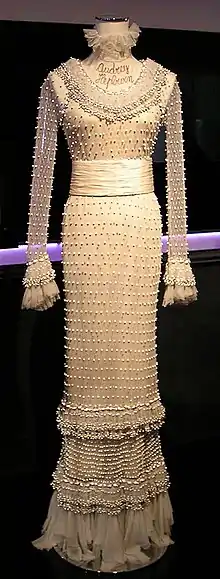Sportswear
Sportswear or activewear is clothing, including footwear, worn for sport or physical exercise. Sport-specific clothing is worn for most sports and physical exercise, for practical, comfort or safety reasons.
_during_the_commissioning_of_the_Navy_Operational_Fitness_and_Fueling_System_(NOF.jpg.webp)

Typical sport-specific garments include tracksuits, shorts, T-shirts and polo shirts. Specialized garments include swimsuits (for swimming), wet suits (for diving or surfing), ski suits (for skiing) and leotards (for gymnastics). Sports footwear include trainers, football boots, riding boots, and ice skates. Sportswear also includes bikini and some crop tops and undergarments, such as the jockstrap and sports bra. Sportswear is also at times worn as casual fashion clothing.
For most sports the athletes wear a combination of different items of clothing, e.g. sport shoes, pants and shirts. In some sports, protective gear may need to be worn, such as helmets or American football body armour.
Sports fabrics are technical materials which help to keep the wearer comfortable during exercise. The type of fabric required will depend upon the intensity of the exercise and the activity. Yoga clothing should use fabrics with exceptional stretch ability for easy movement which will likely require the fabric to be of a knitted construction. Apparel for long distance running will keep the wearer in good comfort if it has excellent moisture wicking properties to enable sweat to transfer from the inside to the outside for the garment. Performance clothing for outdoor sports in the winter or snow sports should use breathable fabrics with very good insulating properties.
Functional considerations


Sportswear is typically designed to be lightweight so as not to encumber the wearer. The best athletic wear for some forms of exercise, for example cycling, should not create drag or be too bulky.
On the other hand, sportswear should be loose enough so as not to restrict movement. Some sports have specific style requirements, for example the keikogi used in karate. Various physically dangerous sports require protective gear, e.g. for fencing, American football, or ice hockey.
Standardized sportswear may also function as a uniform. In team sports the opposing sides are usually identified by the colors of their clothing, while individual team members can be recognized by a back number on a shirt.
In some sports, specific items of clothing are worn to differentiate roles within a team. For example, in volleyball, the libero (a specialist in defensive play) wears a different colour to that of their teammates. In sports such as soccer and GAA codes, a contrasting colour or pattern is worn by the goalkeeper. In other sports, clothing may indicate the current status or past achievements of a participant. In cycling disciplines, the rainbow jersey indicates the current world champion, and in major road cycling races, jerseys of particular colours are worn by the race leader and leaders of auxiliary classifications.
Spandex is the preferred material for form-fitting sportswear, such as used in wrestling, track & field, dance, gymnastics, speed skating, and swimming.
Sportswear is commonly used as a means for the promotion of sponsors of a sportsperson or team. In some sports, there are regulations limiting the size or design of sponsorship brand names and logos on items of clothing.
Thermal properties

Sportswear design must consider the thermal insulation needs of the wearer. In hot situations, sportswear should allow the wearer to stay cool; while in cold situations, sportswear should help the wearer to stay warm.
Sportswear should also be able to transfer sweat away from the skin, using, for example, moisture transferring fabric. Spandex is a popular material used as base layers to soak up sweat. For example, in activities such as skiing and mountain climbing this is achieved by using layering: moisture transferring (wicking) materials are worn next to the skin, followed by an insulating layer, and then wind and water resistant shell garments.
Moisture-wicking fabrics

The moisture-wicking fabrics are a class of hi-tech fabrics that provide moisture control for an athlete's skin. They move perspiration away from the body to the fabric's outer surface where it can evaporate. These fabrics typically are soft, lightweight, and stretchy—in other words, they are perfectly suited for making activewear. Moisture-wicking means that the fabric is absorbent and this can leave a barrier of wet fabric on your skin. Drywicking is the newest variation of moisture wicking. It is a smart two tier fabric that breaks the surface tension of sweat and propels it through the hydrophobic layer into a natural wicking outer layer like cotton where it is assisted by evaporative cooling leaving your skin absolutely dry. Besides the fact that your body can perform better, it will chemically free prevent odors because a bacteria microclimate cannot grow on dry skin. This broad category of fabrics is used to make garments like T-shirts, sports bras, running and cycling jerseys, socks, tracksuits, and polo-style shirts for any physical activity where the goal is to keep your skin as cool and dry as possible. Moisture-wicking fabrics are used to make apparel for outdoor activities such as hiking, fishing, mountain biking, snow skiing, and mountain climbing. Due to the popularity of garments made from these fabrics, more variations are being introduced to the market.
Golf attire

Golf has a long tradition of specialized attire—attire that reflects the tradition of Scottish aristocrats taking in fresh air while walking around the golf course, swinging their golf clubs, and exercising in a refined, genteel sort of way. Golf attire though, is also being influenced by modern fabrics and trends that stress function and durability. Golfers, like athletes in other sports, are athletes first, and public figures second. Athletes in all sports are showing a preference for moisture-wicking fabrics, crisp details, and modern fashionable colors.
Sales trends for activewear
_(cropped).jpg.webp)
As activewear becomes more fashionable and more popular with consumers, sales have increased. Activewear market was valued at $351,164 million in 2017, and is projected to hit $546,802 million by 2024, at a CAGR of 6.5% from 2018 to 2024. North America dominated the global activewear market in 2017, accounting for 42.3% of the total revenue.[1]Asia-Pacific is expected to witness the highest growth rate from 2018 to 2024, due to increase in concerns towards health and wellness and rise in participation of youth population in sports activities.[2]
Some analysts attribute the growth in sales to an intrinsic change in the way activewear is designed. “Historically, what had been available to women were items based on a men's item that were just made smaller and turned a flattering color like pink,” said Scott Key, senior vice president and general manager of Athleta. “Women athletes expected more.” [3] Designers have recognized this "crossover" between exercise and fashion as a major opportunity for growth. It also syncs nicely with the overall trend in American fashion towards a more casual style of dress. The trend has been so popular that it has spawned a new category of casual clothing, athleisure. Rebecca Minkoff is one of the fashion designers who has an entire collection designed around the athleisure concept.
Protective wear

Sportswear also includes the variety of protective gear required for contact sports such as lacrosse, boxing and ice hockey. Different types of protective equipment are needed depending on the type of sport and position. The types of gears include the following: head gear, gum shields, shin pads, shoulder pads, and joint supports and protective gloves.
Head gear
%252C_cropped.jpg.webp)
Head gear is required for most sports with high risk of head injuries such as American football, bobsledding and cycling. Injuries related to the head have the potential to cause serious damage to the spine and may be life-threatening.[4] Although sports like rugby and boxing do not require participants to wear head protection, trainers or referees may choose to depending on the player’s history of head related injuries.[4] Certain positions of some sports may require different type of protections. For example, goaltenders for ice hockey wear different types of face masks compared to other positions.[5] They also have thick gloves with arm pads and shin guards to protect them from the high impact of pucks. In baseball, catchers and batters wear head gear for protection against the high velocity pitches. Head gear of different kinds must meet the standards of protection set by various organizations. Helmets for American football must be regulated by the National Football League or the National Collegiate Athletics Association. Although new rules of safe play have been in effect, players are still in danger of brain damage due to repeated blows to the head.[4] Football players are more likely to develop brain related disorders during or after their careers compared to other sports.[6]
Eye and face shields
.jpg.webp)
Sports of all types may require eye or face protection depending on the players’ need. Face masks come in different forms for different types of sports. In lacrosse and American football, the masks are metal rods attached to the helmet to cover the face.[5] While optional, face masks that might be seen in basketball or rugby are plastic masks that are usually molded to fit the players’ face.[7] Such masks are worn to minimize additional damage to an already injured part of the face.
Eye protection is an additional support provided by sports goggles. Goggles may be worn in lieu of glasses or contacts. Goggles are reliable in the fact that they do not move around while the player is in motion and they protect the eye from foreign objects.[8] For swimmers and divers, goggles keep the water away from their eyes, thus improving visibility.
Mouth guards
Mouth guards are used in many sports including but not limited to: rugby, lacrosse, boxing, water polo, ice hockey, American football, basketball, field hockey, and various martial arts.[9] Mouth guards reduce the risk of sport related dental injuries. Contact or some team sports have a risk of causing injuries related with the mouth, jaw, teeth and oral soft tissues. Wearing mouth guards are not required in any sports but the players are recommended to.[9]
Snow gear and ski apparel

| Part of a series on |
| Western dress codes and corresponding attires |
|---|
|
Legend: |
Different types of attire are needed for extreme weather conditions like snow. Thicker coats or jackets, gloves and boots are necessities in the cold. Winter sports such as snowboarding and skiing require the riders and skiers to be properly geared in the snow. Snow jackets differ from casual coats such that they may be packed with extra insulation and thicker coating materials.[10] The insulation is usually made with down, which is the layer of fine feathers from geese or ducks.[10] These feathers are naturally insulated to keep the birds warm in the harsh winter weathers. The feathers trap air inside and keep the body heat from flowing out.[10] Down is also considered to be the highest quality of insulation for jackets. It is light and compressible. Alternative types of insulation are being invented including: synthetic microfibers and polyester-based insulation.[10] These materials perform as well as down if not better and are becoming popular in the markets with the help of major brands using such materials for their equipment.
Winter gear must also be flexible so that it may offer a wide range of movement. An ideal jacket would have enough insulation to be warm but light, it should be made with material that are not restricting.[11] Jackets with down will be light and warm but they tend to be more expensive. Also down jackets usually are not water-resistant. Synthetic insulated jackets, however, are water-resistant and cheaper than down but lose their insulating factors and are heavier.[11]
In the Olympics, the variety of equipment used contain materials such as aluminum, fiberglass, mineral-based fibers and specialty steel alloys. Skis and snowboards are made up of carbon-fiber, aluminum, titanium and boron-fiber with tungsten alloys. Boots are made with ceramic fibers and steel.[12]
Gender difference
In sports like Tennis, while men generally wear shorts (along with T-shirt or sleeveless shirt), in case of women there is an option of wearing miniskirt or shorts (along with top), as well as minidress (which is a single clothing combining miniskirt and top).
See also
References
- "Activewear Market Expected to Surpass $546,802 Million by 2024, at a CAGR 6.5%". MarketWatch. Retrieved 1 April 2020.
- "Activewear Market Size, Share & Growth | Industry Analysis by 2024". Allied Market Research. Retrieved 1 April 2020.
- Pasquarelli, Adrianne (10 July 2011). "Activewear makes it onto the runway". Crain's New York Business. Retrieved 26 October 2013.
- Protective wear during sport – sports injury prevention. Retrieved 17 March 2016, from Sports Medicine Information, http://www.nsmi.org.uk/articles/injury-prevention/protective-wear.html
- Helmets: How they work and what standards do. Retrieved 17 March 2016, from http://www.helmets.org/general.htm
- Carey, Benedict (31 March 2016). "Study Focuses on Repeated Hits, Not Concussions". The New York Times. ISSN 0362-4331. Retrieved 12 April 2016.
- Protective eyewear for young athletes – 2013 (2013). American Academy of Ophthalmology. Retrieved from http://www.aao.org/clinical-statement/protective-eyewear-young-athletes--november-2003
- Sports and your eyes. Retrieved 17 March 2016, from National Eye Institute, https://nei.nih.gov/sports
- Mouthguards. Retrieved 17 March 2016, from American Dental Association, http://www.ada.org/en/member-center/oral-health-topics/mouthguards
- Berry, G. (28 December 2011). A guide to insulated winter jackets that are not made with down. Retrieved 17 March 2016, from One Green Planet, http://www.onegreenplanet.org/lifestyle/a-guide-to-insulated-winter-jackets-that-are-not-made-with-down/
- Porter, J. (2016). How to choose the best ski jacket. Retrieved 31 March 2016, from http://www.outdoorgearlab.com/Ski-Jacket-Reviews/Buying-Advice
- Olympics 2014: Let the Science Begin! Retrieved 31 March 2016, from United States Geological Survey, http://www.usgs.gov/blogs/features/usgs_top_story/olympics-2014-let-the-science-begin/



